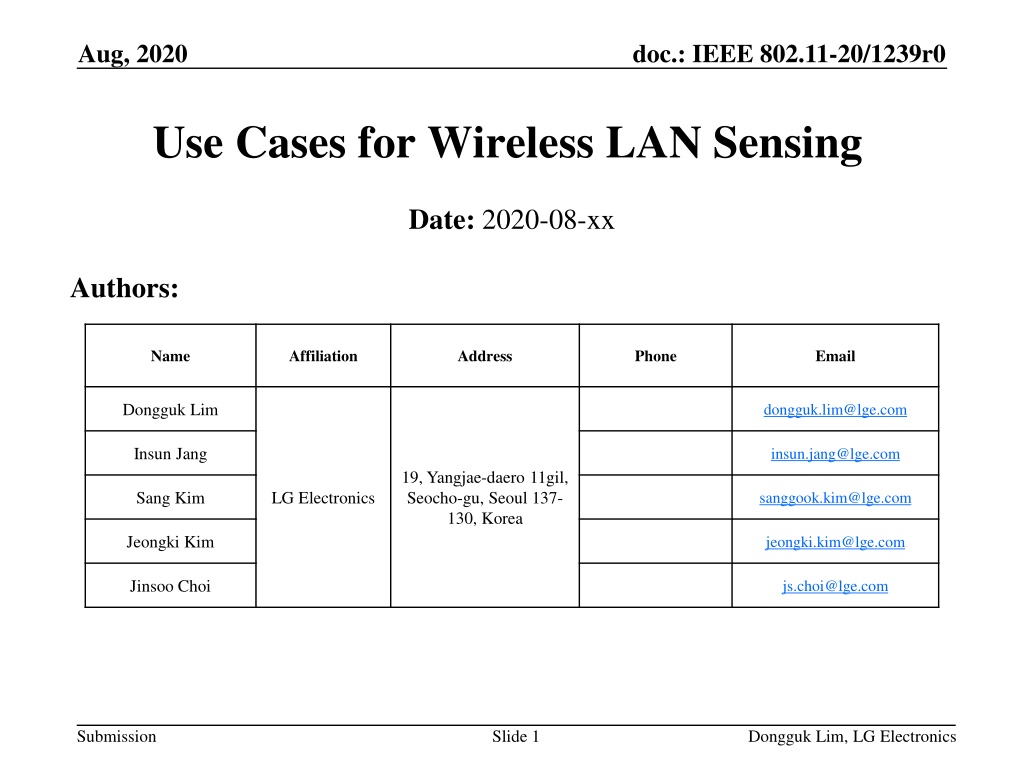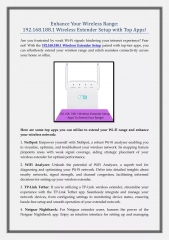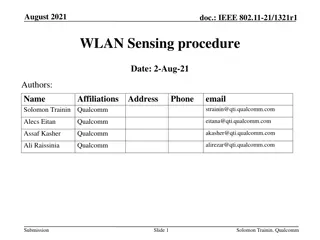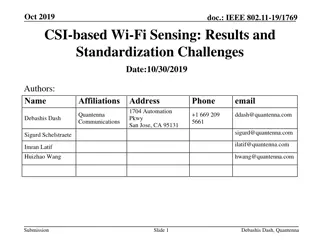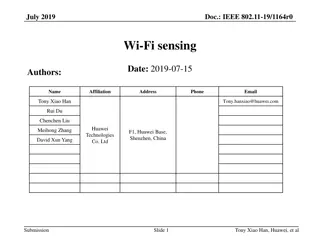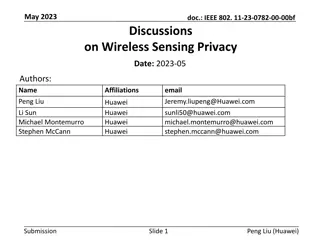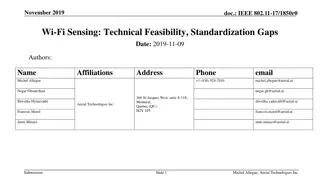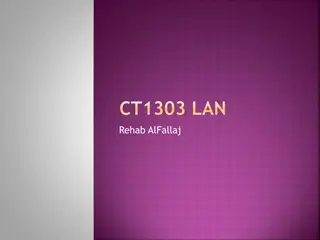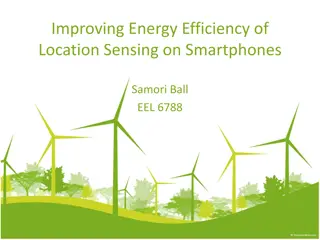Wireless LAN Sensing Use Cases in Home Environments
The document discusses use cases for Wireless LAN (WLAN) sensing in home environments, focusing on the connection between multiple access points and home appliances for enhanced performance. It outlines scenarios such as gesture-controlled home appliance operation, user identification for personalized services, and surveillance of elderly individuals or children using WLAN sensing capabilities. The aim is to explore how WLAN sensing can improve the functionality and convenience of home appliances and provide a seamless user experience.
Download Presentation

Please find below an Image/Link to download the presentation.
The content on the website is provided AS IS for your information and personal use only. It may not be sold, licensed, or shared on other websites without obtaining consent from the author. Download presentation by click this link. If you encounter any issues during the download, it is possible that the publisher has removed the file from their server.
E N D
Presentation Transcript
Aug, 2020 doc.: IEEE 802.11-20/1239r0 Use Cases for Wireless LAN Sensing Date: 2020-08-xx Authors: Name Affiliation Address Phone Email Dongguk Lim dongguk.lim@lge.com Insun Jang insun.jang@lge.com 19, Yangjae-daero 11gil, Seocho-gu, Seoul 137- 130, Korea Sang Kim LG Electronics sanggook.kim@lge.com Jeongki Kim jeongki.kim@lge.com Jinsoo Choi js.choi@lge.com Submission Slide 1 Dongguk Lim, LG Electronics
Aug. 2020 doc.: IEEE 802.11-20/1239r0 Introduction Regarding the usage model/use cases, several contributions[1-3] have been discussed in the previous meetings. In this contribution, we introduce and address the use cases applicable and suitable to WLAN sensing in the home environment. Submission Slide 2 Dongguk Lim, LG Electronics
Aug. 2020 doc.: IEEE 802.11-20/1239r0 Home environment The use of Wireless LAN at home has become common, and, the use of more than one AP at home is getting attention for a stable connection and coverage. Furthermore, many home appliances(i.e., HAs) are being equipped with the connection capability to the Wireless LAN for various services. For example, TV, speaker, air conditioner, refrigerator, air cleaner, washing machine, dryer, electric light and etc. can support the connection through WLAN. Therefore, the various link connection between AP and home appliances can be considered for WLAN sensing as well because these connection can enhance the performance of WLAN sensing. In this contribution, we consider some use cases for WLAN sensing that utilize the home appliance. Also, regarding suggested use cases, the some requirement and KPIs are take into account. Basically, we assume the following conditions. The User does not need to carry a controller/ WLAN device. The user is continuously monitored by WLAN sensing Submission Slide 3 Dongguk Lim, LG Electronics
Aug. 2020 doc.: IEEE 802.11-20/1239r0 Use case #1: Home appliance control 1-1. Control of home appliances by detecting gestures of a user For example, power on/off, operating mode selection, strength control, channel switching, volume control and etc. 1-2. Control of home appliances by detecting presence or movement of a user Automatic control happens when presence or movement of a user is detected within some range of each home appliance. For example, when a user watching TV moves to the bedroom and the situation is detected through WLAN sensing, then the TV is turned off/dimmed or volume-downed automatically. 1-3. Control of home appliances by identifying users Home appliances can provide user-specific services when identifying users. For example, when a user sits down in front of TV, TV identifies who the user is by using WLAN sensing and then, provides program list or schedule that the user is interested in. For another example, when a user comes to the refrigerator, the refrigerator displays customized diet for the identified user on the front screen of the refrigerator or sets a customized dispenser (ex., the water capacity, ice shape or size, etc.) for the identified user. Submission Slide 4 Dongguk Lim, LG Electronics
Aug. 2020 doc.: IEEE 802.11-20/1239r0 Use case #2: Surveillance/Monitoring of elder people and/or children Home appliances are placed at various places in the house, WLAN sensing using the various link connections between AP and those of home appliance(s) can cover the whole house for detecting of the presence in the home. 2-1 Presence or movement detection within home For example, if there is no one in the house and some movement inside the house is detected by WLAN sensing. If it is determined as a unusual, for example, starting at the window, this is notified to current home owner or security. 2-2 Monitoring of identified user Whereabouts of the identified child in the house are not known to a caretaker or identified elder people are staying at home alone, their location and status can be tracked or detected by WLAN sensing. For example, If it detects some troublesome situations such as fall, bump from the identified child or elder people, it is indicated to the parent or family members. This can be useful application of WLAN sensing for deployment in elderly care facilities and daycare center. Submission Slide 5 Dongguk Lim, LG Electronics
Aug. 2020 doc.: IEEE 802.11-20/1239r0 Use case #3: Medical/health care WLAN sensing is used to continuously monitor the user s body movement, for example, abdomen and chest, in real time at the home. For the WLAN sensing-based vital sign of user, the various link connections between AP/wearable and home appliances are used. Also, the biometric data measurements include heartbeat and respiration rates are measured by using the WLAN sensing. This information can be used for monitoring the health of patients/users in a noninvasive and passive manner. In addition, WLAN sensing is useful to detect the immediate change of vital signs for people in unusual situation. If an emergency situation(s), for example rapidly reducing or stopping of heart rate, happens, it is indicated to a medical staffs or family members. This use case primarily targets home deployment for living alone elder people or, however, it is also suitable for deployment in hospital and elderly care facilities. Submission Slide 6 Dongguk Lim, LG Electronics
Aug. 2020 doc.: IEEE 802.11-20/1239r0 Use cases in home Example illustration for use cases When identified user approaching is detected through the WLAN sensing, the screen of the refrigerator turn on and the refrigerator provides the customized services. User moves from TV to refrigerator When the falling of user is detected by WLAN sensing, it is alerted to others. User moves to room when WLAN sensing detects a user is away from the TV, TV turn off the screen or decrease the volume. User3 User2 User1 Through the WLAN sensing, presence or movement of user is detected. When the intrusion is detected by WLAN sensing, it is alerted to others. Intruder Submission Dongguk Lim, LG Electronics Slide 7
Aug. 2020 doc.: IEEE 802.11-20/1239r0 Operation for use cases Example for Sensing operation The home appliances(i.e., STAs) able to support the Wi-Fi are connected to AP in the home. AP(s) sends the sensing request or sensing measurement frame to home appliances periodically. After receiving the sensing request or measurement frame from AP, the home appliances send the response frame or feedback the CSI (i.e., channel status information) to AP. In the first case, the response frame can be replaced with measurement frame or the measurement frame can be transmitted after response frame. By using the CSI that is measured itself or received from home appliances, AP determines the user s movement or gestures. Contrary to the above, the STA(Home appliances) can become the subject to measure the CSI and determine/utilize the information or receive the feedback of CSI from others when it performs the WLAN sensing. HA/AP HA/ AP AP/HA Sensing Req/Measurement frame AP/HA Sensing initiation frame Sensing Res/feedback frame Sensing Measurement frame Sensing Measurement frame Feedback frame Submission Slide 8 Dongguk Lim, LG Electronics
Aug. 2020 doc.: IEEE 802.11-20/1239r0 Requirement Based on the requirements metric in [4] Max Max range (m) Range Accuracy (m) Angular Accuracy (deg) Target Separation (m) Maximum Network Load % speed(m/s) /Speed Accuracy Security/ Protection Robust ness 60GHz Only Use cases details Key KPI Motion detection Mediu m-High 10 < 1 Medium 1-2 N Tracking person and motion/ gesture detection Home Appliance Control Gesture Detection 3* Mediu m-High Medium 5-10 N Surveillan ce/Monito ring of elder people and/or children Tracking person and presence detection Detection and localization of person 10 0.2-2 3/0. 0.5 High High 10 N measureme nts of vital signals Medical/h ealth care Heart/breath ing rate 3 2/0.1 High High 10 N * : This value was set in considering of TV, but it can be changed depending on the type of Home Appliances. Submission Slide 9 Dongguk Lim, LG Electronics
Aug. 2020 doc.: IEEE 802.11-20/1239r0 Summary The number of home appliances with WLAN connection capability is rapidly increasing. In this contribution, we addressed the promising possibility of utilizing home appliances in the setting of WLAN sensing and summarized some possible applications : Home appliance control Surveillance/Care of elder people and/or children Medical/health care As a conclusion, we propose to add the use case of home appliance control into the use case document of 11bf that will be defined. Submission Slide 10 Dongguk Lim, LG Electronics
Aug. 2020 doc.: IEEE 802.11-20/1239r0 Reference [1] 11-19/1725r0, Usage models for WLAN sensing, Rui Du [2] 11-19/1772r0, Presence and Proximity Detection Using WLAN Sensing, Claudio Silva [3] 11/1852r0, In-Car-Sensing-a-60GHz-Usage- example, Solomon Trainin [4] 11-20/936r0, usage-model-document, Assaf Kasher Submission Slide 11 Dongguk Lim, LG Electronics
